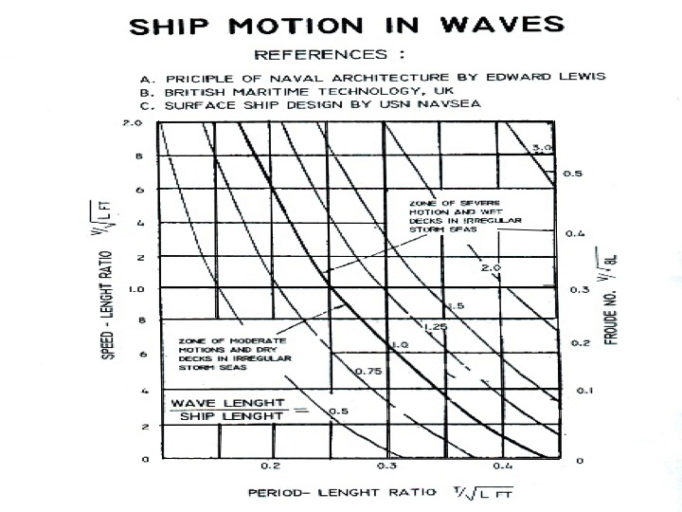INTRODUCTION
The primary mission of a frigate is to defend and strike. The threat assessment is a very crucial factor in the design, combat system outfit and capabilities of a Frigate. An in-depth study and analysis defines the parameters of the ship’s naval architectural design with a variety of sensors, early warning, defensive and offensive capabilities that can match the characteristics and capabilities of the threat in a very high intensity conflict or hostile battle environment.
This article highlights some comments and suggestions on the various requirements and considerations on the acquisition of a Frigate. It tackles the how and what should be done in order to provide proper and effective combination of sensors, early warning and combat systems performance in order to predict the degree of success in neutralizing the perceived threat from the air, surface and sub-surface attacking hostile threat that will interfere in the mission of the Frigate. Fig. 1 is a typical combat system outfit of a frigate.
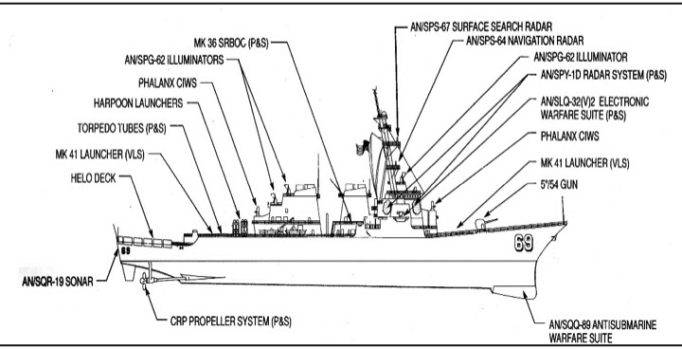
Figure 1
The scope of discussion is limited to the operational environment and climatic condition in the Philippine areas of responsibility, Battle Sphere in air, surface and sub-surface, engagement range, multiple attack and salvo fire, anti-shipping missile sensors, and the conclusion.
COMMENTS AND SUGGESTIONS FOR THE FRIGATE TECHNICAL SPECIFICATION/ACQUISITION OF THE PHILIPPINE NAVY
The term “Fitted For But Not With” (FFBNW) is a misleading statement and it’s very risky to use this as terms of reference. It is accurate to say the words ”Designed For But Not Fitted With” (DFBNFW) which means in naval architectural terms, the space, volume, weight, strength, stability, displacement, power requirements, growth margin, etc. are taken into account (so that when specific types of equipment and weapons are available, all engineering aspects are considered, and the equipment/weapon can be readily installed).
Equipment, sensors and weapon “No Functionality Degradation” is also misleading. This will never happen. We cannot violate the principles of physics and overcome the effects of nature. It is proper to say that it can cope and adjust to compensate the effects of nature and still achieve the minimum performance and capabilities desired.
Maximum speed of 25 knots at 85% maximum continuous rating (MCR). Before adopting this parameter, let us consider first the total patrol areas in terms of square miles within our territorial waters. What is the distance of patrol areas from point to point? Do we always need to go on hot pursuit operation, or is it to show a naval presence? Do we go with the Theory of Mahan or Corbet? Mahan believes in having Command of the Sea, and success is about sinking the other fleet; while Corbet believes in having an appearance of weakness that covers a reality of strength, placing greater emphasis on doing more with less, by using amphibious warfare directed at an enemy’s vulnerable peripheries.
We must adopt an operating profile using the concept and principles of minimum propulsion systems operating time (low load factor) with longer hours of ship patrol time at sea. Speed is very expensive. Fuel is a valuable commodity in ship operation. The greater the speed, the higher load factor is absorbed by the engines and it imposes high stress and shortens the operational life of the engine. Speed is a function of time and distance. How many miles do we need to cover per patrol duration? We must preserve the availability and readiness of the Frigate’s propulsion system to prolong its useful and effective life (but first, we need a Doctrine for our Frigate as basis).
Ship speed limits overall top speed while towed array is deployed. The vessel shall maintain a straight course. Maneuvering or changing course disturbs the Surface Towed Array Sonar’s (SURTAS) effectiveness. The ship will encounter hydrodynamic drag, increasing as a square function of velocity, and could tear the cable and its mooring hardware. The array could be damaged by contact on the seafloor or even damaged if bended too tightly. In shallow water, this is a very difficult task.
Increased Sea State Operation. This can be better explained in terms of Ship Operability Index (SPI) at specific sea state condition (wave height, wavelength, wave crossing time/velocity, probability of occurrence and fetch) at sea areas, Area 40, sea area 52 and sea area 41 of the Philippine area of responsibility. A ship in seaway will never outdo the forces of nature. The ship will always encounter absolute motion amplitude, velocity and acceleration, motions relative to the sea, and motions relative to aircraft or aviation capability. There will be affected areas such as people and equipment, reduced efficiency of sonar, etc. and other performance degradation. Preparation can only be done through the training of crew and identifying the limitation of the ship performance spectrum in a ship polar performance diagram (Fig. 2). We must specify the 12 values of a warship’s performance criteria.
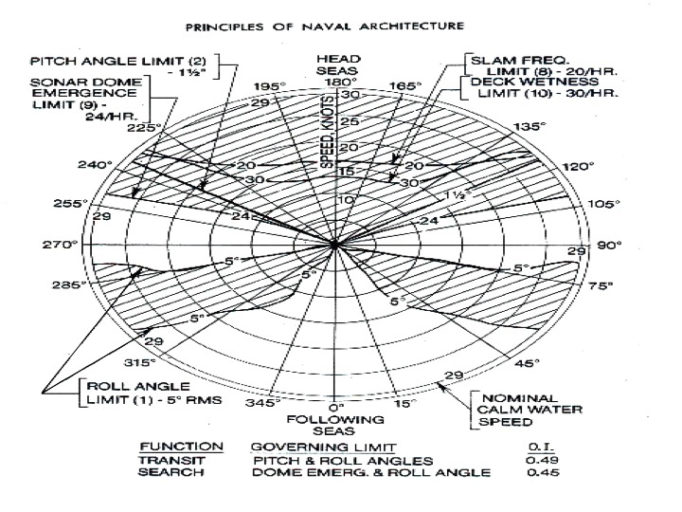
Figure 2
Changes in the Environmental Conditions. A propulsion system performs better in cold regions than in tropical waters because of the increase in temperature in the latter. Engine brakehorse power rating encounters a minimal percentage of reduction of power in tropical regions. Heaters are needed in cold regions, and air-conditioning are needed in tropical waters. Ship displacement is greater in tropical waters and lesser in cold regions; while seawater density is greater in cold water than in warm water ports. The Frigate propulsion system will thus encounter functionality degradation in the Philippine waters, with greater volume of displacement (greater frictional resistance). In contrast, the ship can operate well in cold regions.
Hull Form and Layout for Allocation for Vertical Launch System and Missiles (VLSM) and Surface Towed Array SONAR (SURTAS). The VLS is normally mounted at the forward section between the bow and the bridge while the Towed Array SONAR is placed at the aft section of the hull. This concept will balance the trim moment forward and aft. This is the main reason why they are mounted in opposite locations amid-ship to balance the trim. The towed array SONAR has a length of between 500 meters to 700 meters while being towed behind the propeller. The ship can exert maximum bollard pull in this arrangement. This are the governing parameters why they are located relatively in extremely opposite locations of the hull.
Ship’s Length and displacement: why 95 meters long? Are we now a blue water navy? Ship length is dictated by her mission and operating environment. Fig. 3 is a diagram of Ship Motion in Waves in relation to speed and length ratio, ship length vs. wavelength, where the ship will be at the zone of moderate motion.
Electronic warfare capability. A significant element in Electronic Warfare of a warship is to evaluate first her own susceptibility of attraction by an attacking hostile munition/ordnance with guidance systems that could lock-on to the signature threshold of the target ship. Using a decoy as a means of soft kill method will be useless and ineffective if the acoustic, infrared or radar signature threshold of the ship emits enormous amount of signature greater than the decoy. The sensor of attacking munition/ordnance will not respond (by attraction to the decoy) because what she can see is the predominant signature threshold of the Frigate.
A Combat Management System being used by 1 or 2 foreign navies is meaningless. What we need is a system with proven combat reputation of success.
Helicopter Support Measure. The parameter stated in the technical specification is lacking. It should include the four (4) stages of helicopter landing in a moving ship relative to the movement of the helicopter. These are approaches to landing on the ship: hovering while the ship is moving, landing on the ship’s helicopter deck grid, traversing from deck grid to hangar, and securing. The safety aspect of helicopter launching and recovery must be clearly identified especially in the Polar Performance diagram of the operability and Seakeeping Performance Index (SPI) between the ship and helicopter windows of opportunity. Fig. 2 is a polar diagram of seakeeping characteristics of a warship.
Combination of Deck Guns, Missiles: Torpedoes, Counter-Measure and Ship Signature Threshold. Combination of the aforesaid combat system and countermeasure. Fig. 4 is an illustration of combat system engagement capabilities of graduated response and target prioritization. Fig. 5 is the Frigate’s battle envelope, outlining the forward edge of the circle sphere of influence; the capabilities of early warning, sensors and weapons must be based on this reference diagram.
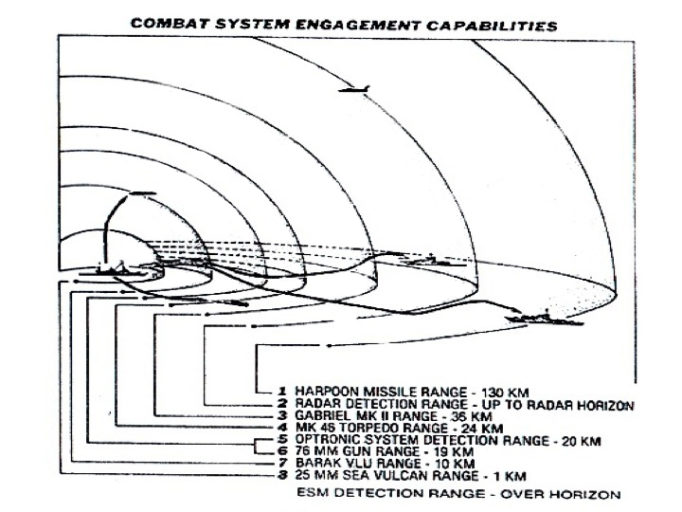
Figure 4
AREA OF OPERATIONS AND CLIMATIC CONDITIONS
Sea Clutter will result in a delayed radar target detection of incoming sea skimming anti-ship missiles. Sea Clutter affects tracking systems, both active radar and Line of Sight Systems (LOS). At low sea state conditions, it will degrade the Close Line of Sight (CLOS) system because of the multipath problem. If Sea Clutter is due to rain and thunderstorm in a tropical region, it will degrade the radar‘s performance.
Humidity and Temperature. All Electro-Optical (EO) systems including passive infrared will degrade under continuous extreme high humidity and very high ambient temperatures.
Electronic Warfare. The Electronic Warfare (EW) deployed by hostile forces can affect the Surface to Air Missile in three (3) ways:
- The tracking radar and guidance system of attacking missile may be degraded by jamming or use of decoys;
- The active surveillance radar may be degraded by jamming; and
- Incoming sea skimming missile will then lock-on to the signature threshold of the ship.
ENGAGEMENT RANGE AND MULTIPLE ATTACK AND SALVO FIRE
Multiple Coordinated Attack. Using surface to Air Missile Defense to acquire a target is very difficult because of various target acquisition issues. Fig. 6 is a typical attack approach of anti-shipping missiles.
Salvo Fire:
- Target characteristic, height of flight, radar cross section, and exhaust temperature like the infrared signature;
- Attacking anti-shipping missile speed; and
- Engagement condition (sea state, humidity and temperature in case of IR).
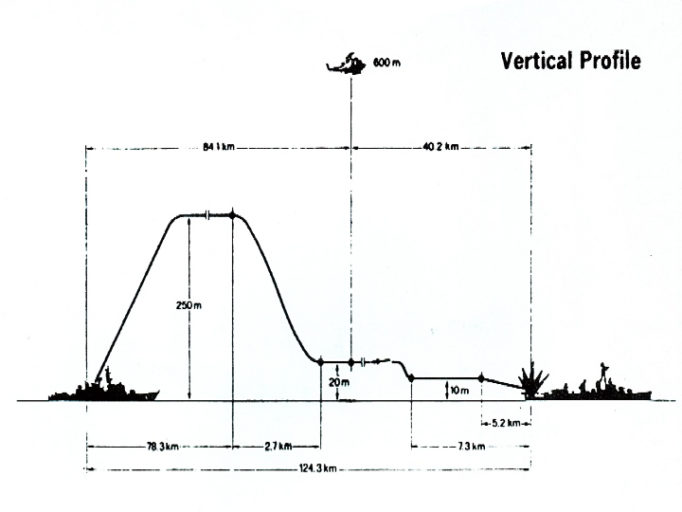
Figure 6
ANTI-SHIPPING MISSILE SENSORS
Active Homing System. A missile carries it own radar transmitter and receivers with which it acquires and tracks the target through a signature threshold of the target ship.
Semi-Active Homing System. The target is illuminated or guided by a separate transmitter, which is usually the firing ship or aircraft. The surface to Air Missile locks-on and tracks the reflected energy from the target signature threshold of the ship.
Passive Homing System. The missile tracks and homes in to the emission from the target. This is a “fire and forget” system by which a missile tracks the infrared signature threshold of the target.
CONCLUSION
The Frigate design consideration, capabilities and performance should be looked at in the context of the Navy’s overall order of battle (Orbat) assessment of the “threat” is a significant and ongoing task of military planners. Realistic assessment and appraisal of potential hostile forces requires continual monitoring and re-appraisal by the intelligence community. A war-gaming scenario must be frequently conducted against a worst-case scenario, and there is a range of various options of case plans that can be formulated. Such assessment of the forces of threat is necessary in establishing the level of our own force’s capability, skills, and training.
__________
References:
- Principles of Naval Architecture by Edward V. Lewis
- Otomat MK2 Anti-Ship Missile System by Finanziaria E. Breda
- BAeSEMA limited, UK Missile Design consideration for the PN
- Litton Ingalls Shipbuilding, USA
- SA’AR 5 Class Israel Shipyard Ltd.
- SAFE COPTER, Helicopter Landing Aid
- USS Vicksburg (CG-69) USN-Wikipedia
- Towed Array SONAR – Wikipedia
- PH Frigate Technical Specification

